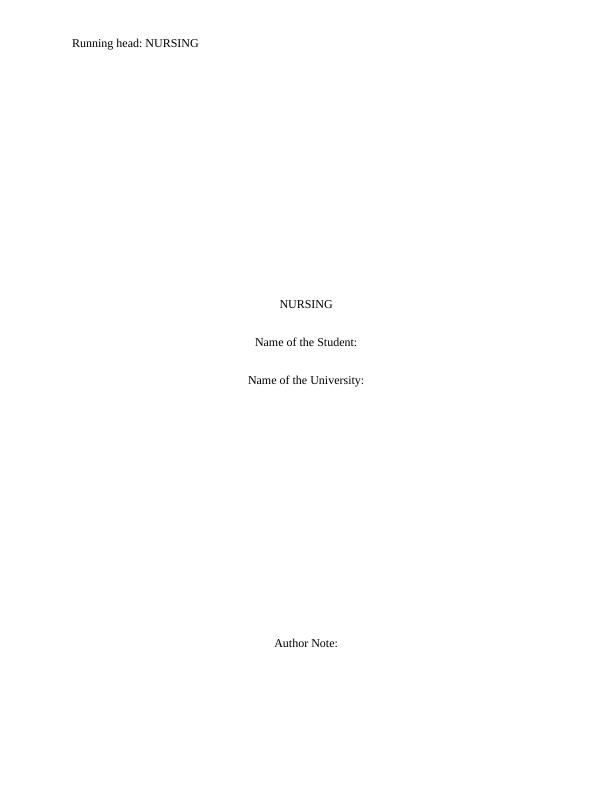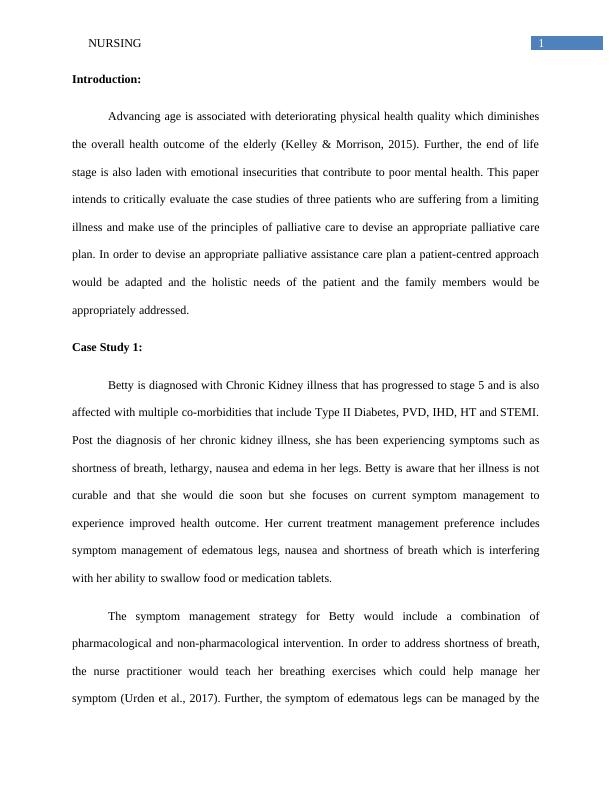Physical Health and Mental Health Case Study 2022
Added on 2022-09-28
6 Pages1590 Words46 Views
Running head: NURSING
NURSING
Name of the Student:
Name of the University:
Author Note:
NURSING
Name of the Student:
Name of the University:
Author Note:

1NURSING
Introduction:
Advancing age is associated with deteriorating physical health quality which diminishes
the overall health outcome of the elderly (Kelley & Morrison, 2015). Further, the end of life
stage is also laden with emotional insecurities that contribute to poor mental health. This paper
intends to critically evaluate the case studies of three patients who are suffering from a limiting
illness and make use of the principles of palliative care to devise an appropriate palliative care
plan. In order to devise an appropriate palliative assistance care plan a patient-centred approach
would be adapted and the holistic needs of the patient and the family members would be
appropriately addressed.
Case Study 1:
Betty is diagnosed with Chronic Kidney illness that has progressed to stage 5 and is also
affected with multiple co-morbidities that include Type II Diabetes, PVD, IHD, HT and STEMI.
Post the diagnosis of her chronic kidney illness, she has been experiencing symptoms such as
shortness of breath, lethargy, nausea and edema in her legs. Betty is aware that her illness is not
curable and that she would die soon but she focuses on current symptom management to
experience improved health outcome. Her current treatment management preference includes
symptom management of edematous legs, nausea and shortness of breath which is interfering
with her ability to swallow food or medication tablets.
The symptom management strategy for Betty would include a combination of
pharmacological and non-pharmacological intervention. In order to address shortness of breath,
the nurse practitioner would teach her breathing exercises which could help manage her
symptom (Urden et al., 2017). Further, the symptom of edematous legs can be managed by the
Introduction:
Advancing age is associated with deteriorating physical health quality which diminishes
the overall health outcome of the elderly (Kelley & Morrison, 2015). Further, the end of life
stage is also laden with emotional insecurities that contribute to poor mental health. This paper
intends to critically evaluate the case studies of three patients who are suffering from a limiting
illness and make use of the principles of palliative care to devise an appropriate palliative care
plan. In order to devise an appropriate palliative assistance care plan a patient-centred approach
would be adapted and the holistic needs of the patient and the family members would be
appropriately addressed.
Case Study 1:
Betty is diagnosed with Chronic Kidney illness that has progressed to stage 5 and is also
affected with multiple co-morbidities that include Type II Diabetes, PVD, IHD, HT and STEMI.
Post the diagnosis of her chronic kidney illness, she has been experiencing symptoms such as
shortness of breath, lethargy, nausea and edema in her legs. Betty is aware that her illness is not
curable and that she would die soon but she focuses on current symptom management to
experience improved health outcome. Her current treatment management preference includes
symptom management of edematous legs, nausea and shortness of breath which is interfering
with her ability to swallow food or medication tablets.
The symptom management strategy for Betty would include a combination of
pharmacological and non-pharmacological intervention. In order to address shortness of breath,
the nurse practitioner would teach her breathing exercises which could help manage her
symptom (Urden et al., 2017). Further, the symptom of edematous legs can be managed by the

2NURSING
nurses with the use of non-pharmacological interventions such as elevation, massage and
assisting the patient with compression stalking (Zyga et al., 2015). The symptom of nausea can
be managed by administering anti-emetic and providing oral care so as to reduce emesis and
promote improved comfort. The evidence base suggests that administration of anti-emetic can
help maintain electrolyte balance which can minimize the tendency of nausea (Zyga et al., 2015).
Key factors that should be considered while devising her preferred end of life care would
include active involvement of her family as she has a strong family network (Kavalieratos et al.,
2016). In addition to this, her culture and religious specific preferences must also be considered
while making referrals to community support services so as to enhance the recovery process
(Garneau & Pepin, 2015).
Case Study 2:
The case study suggests that Lan (English name Amy) is a 59 year old Chinese female
who has recently been experiencing problems with her mental wellness. Amy has recently been
finding it troublesome to retain her memory and feels increasingly exhausted which appears
quite unlikely of her to her son and her mother Mei. Mei had been taking care of her until the
family decides to place her within a residential care facility so as to assist Amy with specialized
care services.
Within the care facility, the multidisciplinary team involved in the care process of Amy
had been witnessing a number of cultural differences between Amy’s culture and tradition
compared to their individual culture and tradition. This is reflected from the first instance when
the worker asks the nurse about why Amy’s family brings in food for her everyday which she
does not consume and despite the provision of food within the residential care facility. The
nurses with the use of non-pharmacological interventions such as elevation, massage and
assisting the patient with compression stalking (Zyga et al., 2015). The symptom of nausea can
be managed by administering anti-emetic and providing oral care so as to reduce emesis and
promote improved comfort. The evidence base suggests that administration of anti-emetic can
help maintain electrolyte balance which can minimize the tendency of nausea (Zyga et al., 2015).
Key factors that should be considered while devising her preferred end of life care would
include active involvement of her family as she has a strong family network (Kavalieratos et al.,
2016). In addition to this, her culture and religious specific preferences must also be considered
while making referrals to community support services so as to enhance the recovery process
(Garneau & Pepin, 2015).
Case Study 2:
The case study suggests that Lan (English name Amy) is a 59 year old Chinese female
who has recently been experiencing problems with her mental wellness. Amy has recently been
finding it troublesome to retain her memory and feels increasingly exhausted which appears
quite unlikely of her to her son and her mother Mei. Mei had been taking care of her until the
family decides to place her within a residential care facility so as to assist Amy with specialized
care services.
Within the care facility, the multidisciplinary team involved in the care process of Amy
had been witnessing a number of cultural differences between Amy’s culture and tradition
compared to their individual culture and tradition. This is reflected from the first instance when
the worker asks the nurse about why Amy’s family brings in food for her everyday which she
does not consume and despite the provision of food within the residential care facility. The

End of preview
Want to access all the pages? Upload your documents or become a member.
Related Documents
Palliative Care Practice: Improving Quality of Life for Patients and Familieslg...
|6
|1550
|250
Palliative Care Practice Case Study 2022lg...
|8
|1793
|19
The comorbidities and complex symptomslg...
|7
|1838
|25
Palliative Care for COPD Patients: Nursing Assignmentlg...
|8
|2003
|406
Assignment (Doc) | Healthcarelg...
|7
|1784
|19
Nursing Assignment: Palliative Care Approach and Care Prioritieslg...
|6
|1771
|40
